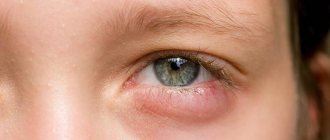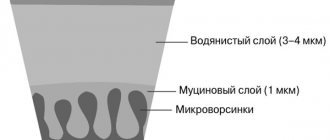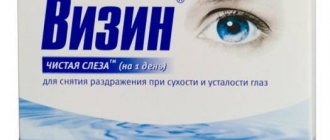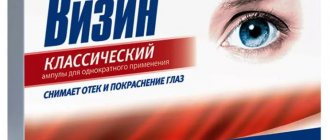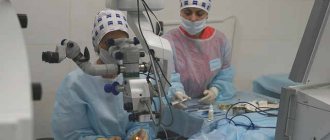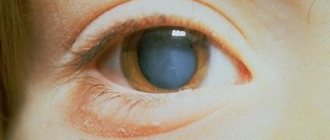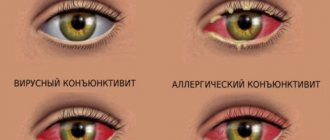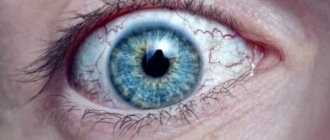Compound
For cataracts, replacement therapy is carried out, based on the administration of substances, the deficiency of which leads to darkening of the lens. Eye drops for cataracts nourish the eye tissue with missing beneficial compounds, improve metabolic processes, thereby protecting the lens from clouding and slowing down the progression of cataracts. Typically, products of this type contain vitamins, amino acids and enzymes, biogenic stimulants, and inorganic salts. This:
- riboflavin (vitamin B2);
- ascorbic acid;
- a nicotinic acid;
- glutathione;
- cytochrome;
- cysteine;
- methyluracil;
- adenosine triphosphoric acid (ATP) solution;
- microelements – potassium, magnesium, calcium.
Video about eye drops for cataracts
Cataract drops are usually used several times daily. The drugs are prescribed in the initial stages of the disease, when the vitamins they contain, biogenic stimulants and inorganic salts (Katachrome, Secatalin) are especially needed. In parallel, it is recommended to use products containing riboflavin, glutamic and ascorbic acids.
Many drugs contain nicotinic acid, which ensures the supply of ascorbic acid to the structures of the eye. Replacement therapy for cataracts is the introduction into the eye of those components, the deficiency of which is especially significant in the development of cataracts.
Various vitamins are also widely used in the drug treatment of cataracts. As a rule, they are used together with a glucose solution (2-5%), which has a beneficial effect on eye nutrition. Calcium, magnesium, potassium, cysteine, and glutathione preparations have also proven themselves well. Cysteine is used to treat any cataracts; it is instilled in courses. This element is often included in many complex drops (for example, Smirnov drops, Vita-Yodurol, Viceina).
Mechanism of action
Eye drops for cataracts are intended for the treatment of various forms of the disease (age-related, congenital, toxic, secondary). Their action is based on:
- regulation of metabolic processes;
- activation of cellular respiration;
- resorption of protein accumulations;
- acceleration of tissue regeneration;
- manifestation of antimicrobial and anti-inflammatory effect;
- removal of toxins and protection from the negative effects of free radicals on tissues;
- moisturizing the mucous membranes of the eye.
Cataract medications activate restoration and metabolic processes in the structures of the eye. But since clouding of the lens is irreversible, medications only help to slow down the development of the disease. At the same time, to achieve a positive therapeutic effect, the drops must be used for a long time. If the drug no longer has a therapeutic effect, you need to contact an ophthalmologist to select another drug.
Eye drops have a positive effect only in the initial stages of the disease. When the form is advanced, the only way to get rid of cataracts is surgery. However, even on the eve of surgery, the use of drops is necessary to reduce the symptoms of the disease.
All eye drops for cataracts are used for a long time. They have virtually no contraindications or side effects, and therefore are safe even with prolonged use. Generally, restrictions on use concern children and adolescents, pregnant and lactating women, people with allergies to the components included in the preparations.
All such drugs act locally, are not absorbed into the systemic circulation, and therefore are combined with drugs for internal use. However, if there is a need to use other eye drops, the decision about their simultaneous use with cataract medications should be made by the doctor.
Typically, when using several types of drops simultaneously, the time between instillations should be at least 15–20 minutes.
Which drugs are better
Eye drops are products that can help only at the initial stage of the disease. Very often during this period, doctors prescribe the amino acid taurine (drugs “Taufon”, “Taurine”, etc.). Taurine stimulates recovery processes in various eye pathologies, so it is used for traumatic, senile, diabetic and radiation cataracts. Since clouding of the lens is irreversible, eye drops for cataracts do not cure or restore the transparency of the lens, they only help slow down the progression of the disease.
It is worth saying that there are a great variety of drugs for the treatment of cataracts. They differ in their effectiveness, composition and cost. The most popular are: “Taufon”, “Oftan Katahrom”, “Vitafacol”, “Quinax”, “Vicein”, etc. These are the drugs that are usually prescribed by an ophthalmologist after an appropriate examination.
When prescribing cataract therapy with eye drops, ophthalmologists give particular preference to Quinax. This drug was developed by international ophthalmology and is considered very effective in the treatment of this disease. The active ingredients of the product are able to protect the lens protein from progressive clouding. However, achieving a positive result is only possible with long-term use of the drug.
Quinax
Quinax
Drops promote the resorption of opaque protein complexes of the lens, stimulate carbohydrate, energy and fat metabolism in the tissues of the eye. They have an antioxidant effect, protecting the lens from the negative effects of free radicals. They are used for congenital, secondary, senile and traumatic cataracts.
Features of therapy:
- drops are intended for long-term therapy;
- after instillation, clarity of vision is lost.
Directions for use: 1-2 drops 3-5 times a day.
Price: 320-580 rub.
Oftan katachrome instructions for use, contraindications, side effects, reviews
A drug for the treatment of cataracts. Drug: OFTAN® CATACHROME Active substance of the drug:
adenosine, cytochrom C, nicotinamide ATC coding: S01XA KFG: Drug used for cataracts Registration number: P No. 015553/01 Registration date: 04/12/04 Registration owner. credential: SANTEN OY {Finland}
Release form Oftan katachrome, drug packaging and composition.
Eye drops in the form of a transparent solution of a reddish color, sour taste.
1 ml cytochrome C 675 mcg adenosine 2 mg nicotinamide 20 mg
10 ml - plastic dropper bottle (1) - cardboard packs.
The description of the drug is based on the officially approved instructions for use. pharmachologic effect
A drug for the treatment of cataracts. It has an antioxidant effect, improves metabolism and trophism of eye tissue. Cytochrome C is a high-molecular iron porphyrin compound, which is isolated in the form of a purified crystalline substance, for example, from the myocardium of cattle. It is a conjugated protein, similar in structure to hemoglobin, consisting of heme and a single peptide chain (apocytochrome C). Cytochrome C plays a critical role in biochemical redox processes in almost all aerobic organisms. These reactions occur with the participation of two mitochondrial enzymes - cytochrome oxidase and cytochrome reductase. Heme exhibits the properties of either an electron donor or an electron acceptor. It is highly reactive to scavenging oxygen radicals such as superoxide or hydrogen peroxide, which is a strong oxidizing agent. Heme metabolites act as scavengers for the peroxide radical. It has been proven that in the lens affected by cataracts, the concentration of cytochrome C is reduced. Cytochrome C is not able to penetrate the cornea in sufficient quantities as a whole molecule. This becomes possible only after cleavage of the peptide chain into a heme-containing nanopeptide, which freely penetrates into the cornea. Inhibition of oxidative processes in all tissues anterior to the lens (including the cornea and intraocular fluid) is of great importance in suppressing the development of cataracts, since ultraviolet radiation causes chain reactions in these tissues with the formation of free oxygen radicals, which have been proven , can lead to clouding of the lens. Heme-containing cytochrome C has the ability to neutralize free oxygen radicals in certain redox processes and thus prevent the development of cataracts. Adenosine is the main element for DNA and RNA repair, as well as a structural element of these molecules, participates in the processes of energy metabolism, and is a paracrine regulator. The vast majority of cataract cases are associated with lens degeneration. DNA repair in the lens epithelium is necessary to restore damage caused, for example, by the damaging effects of oxidation. This requires the presence of adenosine. Due to its vasodilating effect and increased ocular blood supply, adenosine helps flush out toxic waste products, stimulating the production and exchange of intraocular fluid. Adenosine reduces inflammation in the conjunctiva, cornea and other eye tissues; indirectly affects the restoration of glutathiones, since it is a structural element of the enzyme glutathione reductase and reduced NADP, which are necessary to activate the main protective mechanism for suppressing oxidation processes in the lens. Nicotinamide is a structural element of NAD and NADP and is broken down by nicotinamidase to form nicotinic acid. It is believed that nicotinamide promotes the regeneration of endothelial cells of the lens, which helps prevent the development of cataracts. In addition to the therapeutic effect for cataracts, the drug has an anti-inflammatory, antimicrobial and moisturizing effect on the surface of the eye.
Oftan Katahrom
Stimulator of restoration of endothelial tissue of the lens, activating metabolic processes. Due to the adenosine contained in Oftan Katahrom, it has a vasodilating effect and stimulates the synthesis of intraocular fluid. The drops also have an antibacterial effect, preventing the development of inflammatory processes in the eye structures.
Oftan Katahrom is produced in Finland and has been widely used by ophthalmologists in Russia for more than 10 years as a means of slowing the development of cataracts. The drug is produced in the form of eye drops that do not require dilution and is easy to use. In addition to cytochrome C, a powerful antioxidant, the drops contain the energy source adenosine and the vitamin nicotinamide. Such a combined composition provides a clinically proven effect on the development of cataracts.
The main component of the drops, cytochrome C, slows down and in some cases suppresses the process of lens opacification. The drug is used for cataracts of various origins, as well as for the purpose of prevention.
Features of therapy:
- Occasionally, short-term dizziness and arterial hypotension are possible.
Directions for use: 1-2 drops 3 times a day.
Price: ~360 rub.
Taufon
Taufon
The main active component of the drops is taurine. It enhances metabolism and transports oxygen to the eye tissue. For senile, traumatic, radiation, and diabetic cataracts, drops help stop the growth of the spot, causing the cataract to regress. The drug also normalizes intraocular pressure and can be used not only for cataracts, but also in the treatment of traumatic and dystrophic lesions of the cornea, open-angle glaucoma.
Features of use: the product is contraindicated in patients under 18 years of age.
Directions for use: 2-3 drops 2-4 times a day for 3 months. The course is repeated a month later.
Price : 120-140 rub.
Catalin
Drops are used to treat senile cataracts in the initial stages. Sodium pyrenoxine contained in them has an anti-cataract effect. It improves metabolic processes in the lens and prevents protein denaturation.
Features of therapy:
- do not use simultaneously with drops containing zinc sulfate, silver solution, collargol;
- after instillation, lacrimation, burning, and redness of the eye mucosa are possible. Catalin
Directions for use: ophthalmic solution (to prepare it, the tablet is dipped into a solution with a solvent) instilled 1-2 drops 5-6 times a day.
Price: 370-420 rub.
Recommended analogues
The following drops have a similar effect: Quinax, Vita-iodurol, Catalin, Solcoseryl, Cytochrome C, Etadex-MEZ, Khrustalin.
Quinax
The drug is produced in Belgium. Currently not produced or supplied to Russia. Previously, its cost was 350-450 rubles.
Drops are used for senile, congenital, traumatic and secondary cataracts. Their main property is the ability to absorb opaque proteins of the lens, which give turbidity. They also improve metabolism in eye tissues.
The drug should be stored in the refrigerator to ensure better preservation.
Vita-iodurol
French drops improve nutrition and metabolism of the lens, metabolism and blood supply to the eye. With a course of use, there is less protein deposition in the lens, and it becomes less cloudy.
The medicine is safe for use; allergic reactions may occur.
Catalin
This is a new drug produced in Japan. It is prescribed for senile and diabetic cataracts. With long-term use, it restores the functions of the lens and prevents its destruction.
Possible adverse reactions: pain, itching, allergic manifestations, blepharitis.
The cost of the product is 380-650 rubles.
Solcoseryl eye gel
The drug heals the cornea after injuries, burns, and inflammations. It also restores eye tissue, improves metabolic processes in them, eliminates itching, dryness, fatigue and other symptoms of “dry eye”. The price of the gel is 380-485 rubles.
When used, allergic reactions and a short-term mild burning sensation are possible. The second side effect is not a reason to discontinue the drug.
Cytochrome C
The domestic drug is used for dystrophy and clouding of the cornea, keratitis. It restores eye tissue, stimulates metabolic processes, improves blood supply and oxygen delivery to tissues.
Possible side effects when using drops: allergic reactions, short-term burning and redness of the conjunctiva.
The drug component is part of the drug Oftan Katahrom and determines its effect.
Etadex-MEZ
This Russian remedy is used after surgical removal of cataracts, for dry eye syndrome and dystrophy.
It restores and heals the spherical surface of the cornea, improves visual acuity, relieves pain and swelling.
Khrustalin
The drops are identical in composition to the drug Oftan Katahrom. They are used for clouding and hardening of the lens. If the course doses are followed, the medicine relieves irritation and eye fatigue, moisturizes and neutralizes inflammation, and maintains visual acuity.
Oftan Katahrom and its analogues should not be used when wearing contact lenses. During treatment, they should be removed and reinstalled 15 minutes after instillation.
Also, special care should be taken when driving a car and other dangerous activities. When treated with cataract medications, short-term lacrimation and decreased vision are possible. Therefore, after instillation, at least 20 minutes must pass before starting activities.
Author's rating
Author of the article
Alexandrova O.M.
Articles written
2029
about the author
Was the article helpful?
Rate the material on a five-point scale!
( 16 ratings, average: 4.44 out of 5)
If you have any questions or want to share your opinion or experience, write a comment below.
